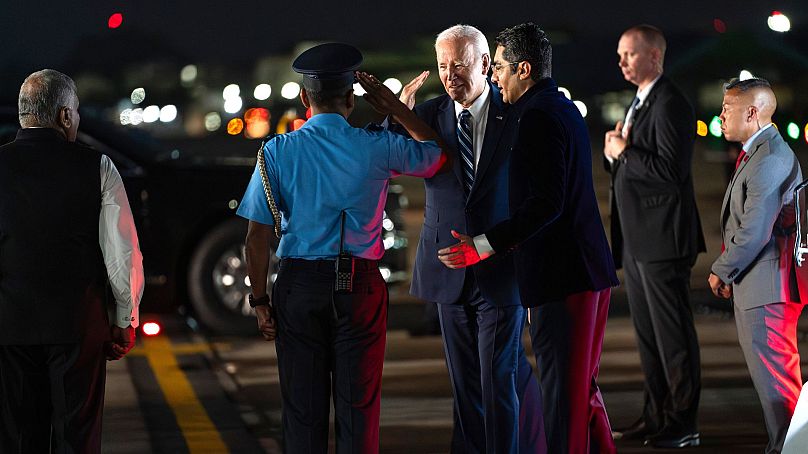The G20 summit opens in Delhi tomorrow. What does it mean for the climate?
G20 leaders must act now to avoid “catastrophic” climate disaster, campaigners have warned.
The annual summit opens in Delhi tomorrow, bringing together the presidents and prime ministers of the world’s most powerful economies.
Host country India has highlighted “sustainable development” as one of the conference’s major topics.
But this theme must go beyond empty words, Amnesty International has urged.
Wealthy countries must provide at least US$100 billion (€116 billion) in climate finance and cancel the debts of the poorest countries.
“The G20 is happening while the world teeters on a knife-edge,” warns Agnès Callamard, Amnesty International’s Secretary General.
“The climate crisis is inflicting immense harm on people while at the same time many climate-vulnerable states face a debt crisis. The human rights of billions of people are threatened.”
What is the G20 summit?
The G20 - short for the Group of 20 - is a group of countries that meets annually.
The “premier forum for international economic cooperation,” it brings together the most powerful nations in the world.
Between them, members account for 75 per cent of world trade and 85 per cent of world economic output.
The EU is one member. The others are Argentina, Australia, Brazil, Canada, China, France, Germany, India, Indonesia, Italy, Japan, Mexico, Russia, Saudi Arabia, South Africa, South Korea, Turkey, the UK and the US.
Founded in 1999, the forum has met every year since 2008. The members attempt to coordinate world economic policy, while national leaders conduct bilateral meetings with one another on the side.
What is on the agenda at the G20 summit 2023 and how much can the G20 do?
India has identified the climate crisis as the most pressing issue for conference delegates.
Topics on the agenda include green development, climate finance and debt forgiveness for lower-income countries.
But how much can the G20 really do?
Last year, divisions over the war in Ukraine meant that the conference ended without a joint statement.
This year, China’s Xi Jinping will skip the meeting, as will Vladimir Putin.
And even when the group does issue statements, they are rarely linked to specific policy action.
For example, the 2021 Rome summit ended with a promise to limit global warming with “meaningful and effective action” and a plan to end overseas coal power plant financing. But in 2022, coal-fired power generation reached a record high.
The G20’s decisions are not legally binding. Nonetheless, it does have power as an agenda-setter, a kind of global steering committee.
This is why G20 leaders must take decisive action on the climate crisis, Amnesty International has claimed.
“The cost of inaction will be catastrophic,” Callamard says.
What does Amnesty International want the G20 to do?
The campaigning organisation is urging rich countries to cancel the debt of poorer countries.
Many low-income countries are in debt to rich countries and financial institutions like the International Monetary Fund and the World Bank. Borrowing money used to be more affordable, but inflation has driven up prices and interest rates for loans.
Servicing this debt consumes money that could be spent on vital services or climate adaptation. For example, Nigeria spends around 96 per cent of its government revenue to pay off its national debt.
One in five people on the planet now live in a country that's at or nearing what's called "debt distress" - meaning it has reached a high likelihood that it will default on its loans.
If a country defaults, its credit rating will plummet and borrowing money becomes nearly impossible, making it hard to pay for any basic services. This is the vicious debt cycle.
Amnesty is calling on the G20 governments to restructure debt relief processes.
“The number of low income countries in debt distress has risen since the COVID-19 pandemic to 42, hampering their ability to safeguard people’s rights, especially because many face recurrent climate shocks,” Callamard says.
“It is vital that the G20 acknowledges the magnitude and urgency of these crises and acts swiftly to stop the climate and debt disasters escalating.”
What should the G20 do about climate financing?
In 2009, a coalition of economically developed countries - including the USA, France, Germany, and the UK - pledged to give climate-impacted nations $100 billion (€116 billion) per year by 2020. The pledge has not yet been met.
It will likely be on the agenda at the G20, as India has previously called on these governments to “substantially enhance” this ambition.
But adaptation funding - though important - is not enough.
“Rapidly phasing out all fossil fuels must be the global priority to avoid a climate catastrophe and further human rights abuses,” Callamard says.
“The world is heading towards a climate disaster and the distress signals are obvious.”












